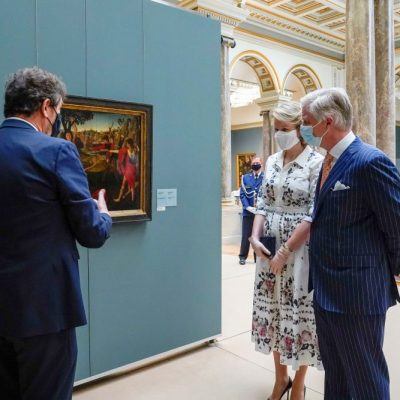In recent weeks, there has been a gradual realisation in the United Kingdom that social-distancing measures will continue, to a greater or lesser extent, until at least spring next year. This is thought to be the earliest that it is likely that there could be a widely available coronavirus vaccine, and when the UK will have the ability to effectively test and track outbreaks. There are now, however, some chinks of light for art businesses. Following recent lobbying by trade bodies of the UK government, auction houses and art galleries are thought to now be classified as ‘non-essential retail businesses’ which means that they may be able to reopen to the public in June as part of phase two of the government’s plan to ease the lockdown.
It is understood that careful thought is still being given by the Department of Digital, Culture, Media and Sport to logistical factors, but the general feeling seems to be that even if art businesses need to impose the same strict social-distancing measures as those currently adopted by essential businesses (such as supermarkets) then those businesses will adopt them and get the wheels of the art market turning again. (Some details as to how this might work can be found here.) We are unlikely to see packed live auction rooms or crowded gallery private views for some time to come, but the resumption of viewings, even if by appointment, is a positive prospect. This will also come as promising news to art shippers and handlers. Museums will likely have to wait longer for any form of reopening.
On 12 May, the chancellor, Rishi Sunak, extended the government’s furlough scheme from the end of June to the end of October (with the grant payable to eligible employers decreasing from the start of August). This is a welcome development as businesses look to stave off potential redundancies in the sector, and in allowing time for the UK art market (and the broader economy) to pick up.
The entire UK art market generated $12.7 billion in 2019 (according to the Art Basel & UBS Art Market Report 2020, written by Clare McAndrew), but it is a fragmented market. According to the British Art Market Federation’s (BAMF) most recent survey on the subject (2017), there are more than 7,580 businesses operating in the British art and antiques market, directly providing some 42,000 jobs. The majority of these businesses have fewer than 20 employees. These small or medium-sized business – many of which are family and/or owner-managed businesses – will, I hope, have benefited from the furlough scheme, as well as from any rental concessions, grants and government-backed loans they have been able to obtain over the last few months.
In a world in which the moral scrutiny of wealth is becoming ever more prevalent – particularly in relation to those who have been able to take advantage of the government’s various schemes, grants and loans – it is essential that the art market positions itself correctly. The art and antiques sector may be a place in which exclusive items are sold to wealthy individuals, but most importantly it is a sector of entrepreneurs who employ tens of thousands of people, support artists and indirectly support thousands more satellite businesses such as framers, conservators and valuers. According to BAMF, in 2016 auction houses and dealers spent more than £3.3 billion on specialised services in ancillary industries, and it is estimated that this expenditure directly supports a conservatively estimated 94,710 further jobs in the UK economy.
Of course, many London-based dealers were already challenged by rental costs prior to the current crisis. It is likely that the pre-Covid 19 trend of moving from ground-floor galleries to walk-up viewing rooms will continue. If viewing by appointment (which is set to become the norm for the second half of 2020) proves to be a workable solution for generating sales, and if staff members enjoy working from home a few days a week (or full time), we may see very different patterns of doing business.
It remains to be seen whether art can exclusively be sold online, particularly at the higher end of the market. Pre-crisis, online sales made up only nine per cent of global sales in art and antiques by value. The online and social media presences of galleries have been massively augmented over the last few months by way of galleries’ own endeavours, as well as sales platforms launched by third parties (such as David Zwirner’s Platform and the Sotheby’s Gallery Network, the latter crossing a Rubicon some would surely never have imagined three months ago). All the same, some of this activity may essentially amount to a content-creation exercise, with a view to client engagement and cultivation, rather than lead to significant sales without physical viewing.
Where art galleries do make ‘distance sales’ (broadly, sales conducted exclusively online and/or over the phone) to consumers (whether through their own website or through a third-party platform), there are important legal ramifications to be taken into account. These complex legal requirements include that consumers must be told (before entering into the sale contract) that they have the right to cancel the purchase for a full refund within a 14-day cooling off period (and be provided with the form of a cancellation notice). If purchasers are not told about that right, broadly speaking the cancellation period will be extended by a year. Additionally, if such consumers are not told that they would have to pay for any return deliveries if they exercise their right of cancellation, then the seller will have to pay that return delivery charge. Where selling galleries are passing on a share of sale proceeds for an artwork to an artist or consignor, they should keep in mind the duration of the cooling-off period (during which the client may cancel the sale and claim a full refund).
Galleries should also remember that what is said about artworks for sale online may in the future be interpreted as a term of the sale contract or be deemed to be a misrepresentation, so control of the creation of online content is important. Anything published online must also comply with copyright, data protection and privacy laws. Generally, website and social media use needs to tie in with the gallery’s terms and conditions of online sale.
When exhibiting/selling on a shared online platform owned and operated by a third party, it would be wise for galleries to understand what information that third party obtains when their collector base views artworks through the platform, and how that third party can use any such data. In addition, they ought to fully understand the other commercial terms pursuant to which use of the platform is provided, such as whether there is a cost for listing or a commission payable on sales. Galleries also need to think about how they should conduct anti-money laundering client due diligence in the context of online sales. Risk is heighted when sales are not conducted face to face.
Additionally, cybercrime is said to be on the rise in the current crisis. Taking simple steps such as calling a verified telephone number to confirm bank account details before sending money, or to confirm a delivery address before delivering an artwork, can be an effective tool in the battle against it.
On a happier note, I recently listened with interest to my friends at Wednesday Agency (a leading creative agency for fashion, cultural and lifestyle brands) who predict, among other trends for the luxury sector, two developments that I believe will be highly relevant to the art sector moving forwards. The first of those is the prediction of further, and new modes of, brand collaboration. We have seen much of this already during the health crisis, and it is hoped this trend will give further impetus to initiatives such as the New Art Dealers Alliance’s (NADA) profit-sharing virtual fair. The second projection is that consumers will increasingly focus on enduring value. My hope is therefore that the art sector – a market all about unique and enduring objects – can harness this predicted shift in consumer attitudes, and successfully manage the first chapter in the post-lockdown story despite the huge challenges ahead.
Sarah Barker is a Partner and Head of the Art Group at law firm Lee & Thompson LLP
This article does not constitute legal advice and should not be relied upon. If you require legal advice in relation to any of the issues raised in this article, then specific legal advice should be sought on a case by case basis.



